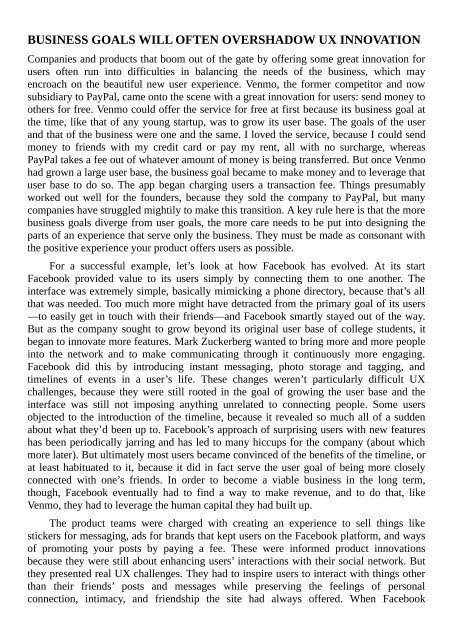You also want an ePaper? Increase the reach of your titles
YUMPU automatically turns print PDFs into web optimized ePapers that Google loves.
BUSINESS GOALS WILL OFTEN OVERSHADOW UX INNOVATION<br />
Companies and products that boom out of the gate by offering some great innovation for<br />
users often run into difficulties in balancing the needs of the business, which may<br />
encroach on the beautiful new user experience. Venmo, the former competitor and now<br />
subsidiary to PayPal, came onto the scene with a great innovation for users: send money to<br />
others for free. Venmo could offer the service for free at first because its business goal at<br />
the time, like that of any young startup, was to grow its user base. The goals of the user<br />
and that of the business were one and the same. I loved the service, because I could send<br />
money to friends with my credit card or pay my rent, all with no surcharge, whereas<br />
PayPal takes a fee out of whatever amount of money is being transferred. But once Venmo<br />
had grown a large user base, the business goal became to make money and to leverage that<br />
user base to do so. The app began charging users a transaction fee. Things presumably<br />
worked out well for the founders, because they sold the company to PayPal, but many<br />
companies have struggled mightily to make this transition. A key rule here is that the more<br />
business goals diverge from user goals, the more care needs to be put into designing the<br />
parts of an experience that serve only the business. They must be made as consonant with<br />
the positive experience your product offers users as possible.<br />
For a successful example, let’s look at how Facebook has evolved. At its start<br />
Facebook provided value to its users simply by connecting them to one another. The<br />
interface was extremely simple, basically mimicking a phone directory, because that’s all<br />
that was needed. Too much more might have detracted from the primary goal of its users<br />
—to easily get in touch with their friends—and Facebook smartly stayed out of the way.<br />
But as the company sought to grow beyond its original user base of college students, it<br />
began to innovate more features. Mark Zuckerberg wanted to bring more and more people<br />
into the network and to make communicating through it continuously more engaging.<br />
Facebook did this by introducing instant messaging, photo storage and tagging, and<br />
timelines of events in a user’s life. These changes weren’t particularly difficult UX<br />
challenges, because they were still rooted in the goal of growing the user base and the<br />
interface was still not imposing anything unrelated to connecting people. Some users<br />
objected to the introduction of the timeline, because it revealed so much all of a sudden<br />
about what they’d been up to. Facebook’s approach of surprising users with new features<br />
has been periodically jarring and has led to many hiccups for the company (about which<br />
more later). But ultimately most users became convinced of the benefits of the timeline, or<br />
at least habituated to it, because it did in fact serve the user goal of being more closely<br />
connected with one’s friends. In order to become a viable business in the long term,<br />
though, Facebook eventually had to find a way to make revenue, and to do that, like<br />
Venmo, they had to leverage the human capital they had built up.<br />
The product teams were charged with creating an experience to sell things like<br />
stickers for messaging, ads for brands that kept users on the Facebook platform, and ways<br />
of promoting your posts by paying a fee. These were informed product innovations<br />
because they were still about enhancing users’ interactions with their social network. But<br />
they presented real UX challenges. They had to inspire users to interact with things other<br />
than their friends’ posts and messages while preserving the feelings of personal<br />
connection, intimacy, and friendship the site had always offered. When Facebook


